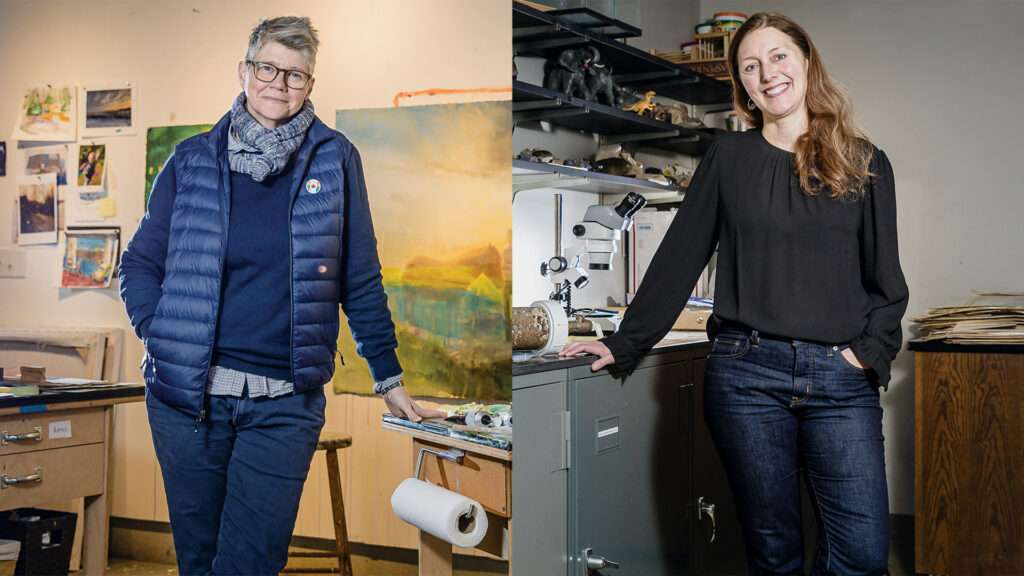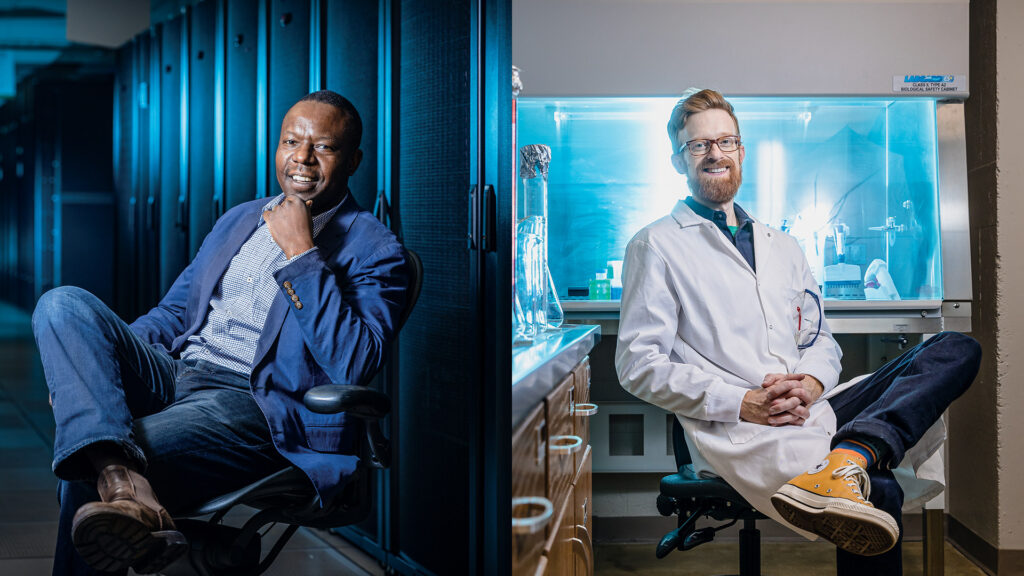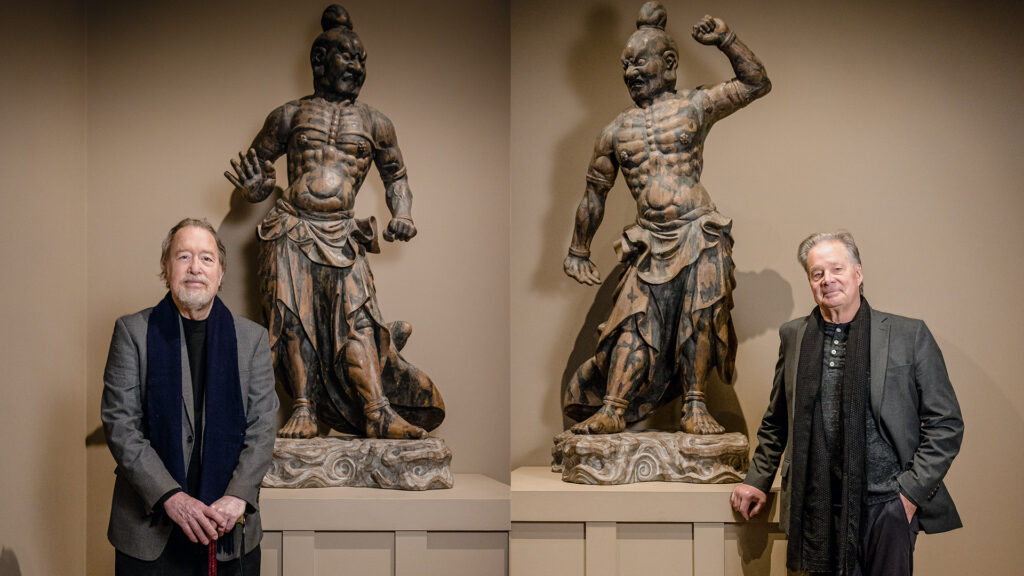
Team-taught courses bring together Mac experts across disciplines to explore the terrain—and sometimes, the tensions—of complex topics.
By Erin Peterson / Photos by David J. Turner
Two decades ago, associate computer science professor Getiria Onsongo ’04 did a summer research project with Macalester professor Libby Shoop that changed his life.
The project, which focused on developing data exploration tools for biological data, offered Onsongo a meaningful experience in computational biology, a field that uses computational techniques to understand biological systems.
The research helped him see how he could combine his longtime interest in health care with his natural strengths in computer science—instead of being forced to choose one or the other. “It opened a path I didn’t know existed before,” he recalls. “It changed the trajectory of my whole career.”
Today, as an associate professor of computer science at Macalester, Onsongo wants to bring similar perspective-shifting moments to current students. That’s why he and biology professor Robin Shields-Cutler teamed up to teach a course in computational biology. Shields-Cutler earned his PhD studying microbiology and infectious diseases, and learned computational techniques later in his training. “It changed the way that I think about solving problems,” he says, “in part, by adding this incredible new toolbox of methods.” Now, Shields-Cutler uses these techniques in his research to study complex dynamics of the gut microbiome.
Pairing biological insights with a range of computational techniques, the course is designed to enrich students’ understanding of the rapidly expanding field, which plays a role in everything from identifying new coronavirus variants to enabling new applications of personalized medicine.
For both Onsongo and Shields-Cutler, team teaching has offered new ways to strengthen their teaching and build on each other’s expertise. Students, including Eliza King ’23 (Novato, Calif.), have experienced a similar widening of possibility that Onsongo had some two decades ago. “Having two professors who are experts on the two different areas of the class is helpful,” says King, a biology major with an English minor. She hopes to use the coding and data analysis skills she’s honed from the course to pursue work linked to wildlife conservation.
While not limited to the liberal arts, team-taught courses seem ready-made for Macalester students—opportunities to pair sometimes disparate disciplines, find common vocabularies, and stretch imaginations. In a world with increasingly complex and multifaceted problems, those who find ways to bridge multiple disciplines and perspectives will be poised to make significant impact.
In the pages that follow, faculty from three co-taught courses discuss how they expand their areas of focus through team teaching—and students share the insights they’ve gleaned from the experience.

Course #1: Land/Water
Landscape exploration through art and science
Geology professor Kelly MacGregor and art professor Chris Willcox teach Land/Water, which uses journals, sketching, scientific measurements, and prompts to investigate landscapes in Minnesota scientifically and artistically. Rola Cao ’25 (Nanjing, China) is a double major in psychology and anthropology.
Kelly and Chris, what led you to the development of this course?
MACGREGOR: As faculty members at a liberal arts college, we’re both interested in the intersection between the science and art of landscapes. Chris and I kept coming back to how both scientists and artists use field notebooks to document and explore landscapes and water around them.
WILLCOX: The more we talked about it, the more we realized how rich the interchange between our disciplines is.
MACGREGOR: Our course uses science journaling and art journaling to explore the world around us. Where are the commonalities between the practices of science and art? How can we use one to understand the other?
Rola, why did you take this course?
CAO: I spent the first nineteen years of my life in a city nurtured by the third longest river on earth, the Yangtze River. The river significantly affects the local weather, culture, and lifestyle, and I wanted to explore the topic. I also had a deeper reason that compelled me to take this course: my grandfather was a cartographer and participated in the construction of the world’s biggest dam, Three Gorges, in the 1990s. He passed away during my first year of college and I couldn’t see him for the very last time. I see this class as an opportunity for me to honor him, to reconcile loss, and to heal from grief through exploring the art and science of nature.
Kelly and Chris, tell me about a project you’ve done in class.
MACGREGOR: We went to the Root River in southeastern Minnesota on an overnight trip and had students calculate water discharge to understand what the flow was like. Half of them were in hip waders and using equipment to make measurements of the channel, and they created a cross section of it.
WILLCOX: I had the other half, who were painting that same landscape. Then they swapped, so they got to experience both things.
How does having experts in two disciplines shape the classroom experience?
WILLCOX: When students are field journaling—art book–type journaling—I have them complete thoughts that start with the prompts “I notice,” “I wonder,” and “It reminds me of.” That’s very similar to how Kelly talks about constructing scientific experiments. A lot of our work is ultimately about slowing down and really noticing things.
CAO: In a traditional classroom, the voice of one professor has an irrefutable authority. But with two professors, it’s an ongoing dialogue. They often offer insights on how art and science can complement each other. Scientific cartography can benefit from artistic embellishment. Art and journaling can inspire a long-lasting curiosity about science and nature.
What do you hope students take away from this class?
MACGREGOR: I want to give students a sense of hope. As part of the class, students sat in a spot that used to be a prairie, then became a farm, and is now turning back into a prairie. I hope they can see the beauty in this change.
WILLCOX: I want students to take away a sense of wonder about the natural world that “slow looking” can inspire. Prolonged, deep looking is rewarding and a skill to be cultivated. I hope students continue to pause and truly see what’s around them, as artists do, and continue to paint and draw to develop their skills.

Course #2: Computational Biology
An under-the-hood look at biological topics through a computational lens
Associate computer science professor Getiria Onsongo ’04 and assistant biology professor Robin Shields-Cutler explore topics including bioinformatics and algorithms in genome analysis. Ahmed Abdalla Ahmed ’23 (Omdurman, Sudan) is a computer science and environmental studies major.
Getiria, you were inspired to teach a version of this course after doing summer research on a similar topic as a student. Robin, what made you excited about team-teaching a course like this?
SHIELDS-CUTLER: I was excited to work with Getiria, and I knew that together we could teach far more deeply on both sides of this field than we could individually.
Can you give some examples of how these two fields work together?
SHIELDS-CUTLER: We use DNA and RNA sequences to understand so much about our world today, and those sequences can be massive. As one example, the coronavirus genome itself is relatively simple in biological terms—about 30,000 bases, compared to a human’s 3 billion—but scientists are looking at thousands of them in real time to try to identify changes, or variants, that might be important to keep an eye on. Because of the amount of the data being analyzed, these biological problems are also, necessarily, a computational exercise.
These techniques are also important for emerging areas like personalized medicine, in which medical interventions can be tailored to individuals based on their genetics and other factors. In the class, students write computer code for algorithms that form the basis for most DNA analysis tools. They use the same kinds of tools and techniques that thousands of labs across the world are using every day.
How do two distinct viewpoints come together as part of a single course?
ONSONGO: We teach every class together. When Robin is covering heavy biology stuff, I might hop in and talk about the tools behind it. And if I’m covering mostly computer science stuff, he might jump in to talk about why a particular topic is important.
AHMED: It is cool to see how Professor Onsongo and Professor Shields-Cutler go back and forth to explain their own expertise. They show humility in yielding to each other’s expertise, but also collaboration at the same time. Both ideas are integral to the scientific process.
What are the larger lessons you hope students take from their experiences in your classroom?
SHIELDS-CUTLER: There are so many buzzy topics—things like personalized medicine and your gut’s microbiome—that are derived from analyses that use the kinds of algorithms that we teach in this class. We also want students to be critical consumers of the scientific information they’re seeing, because there can be a lot of inaccurate or misleading information that gets published in the popular press and shared online.
ONSONGO: I also hope that students see the value of collaborating and working in teams. You might not become a biologist, but knowing some biology—and knowing a biologist!—is useful if you want to solve some types of problems. Similarly, if you are a biologist, you don’t need to have a degree in computer science to incorporate computational techniques in your work. Interdisciplinarity can help you solve problems that you can’t solve yourself.

Distinguished Professor in the Humanities and Fine Arts J. Andrew Overman (R)
Course #3: India and Rome
The surprising history that influences us today
Arnold H. Lowe Professor of Religious Studies Jim Laine and Harry M. Drake Distinguished Professor in the Humanities and Fine Arts J. Andrew Overman explore the relationship between empire and religion from Rome to India for the thousand years between Alexander (336 BCE) and the rise of Islam (800 CE). Claire McDayter-Hunter ’25 (Lewisburg, Penn.) is a double major in geology and classical archeology.
Tell me about the idea behind this course.
OVERMAN: So much of the American academic curriculum has an emphasis on Western centers. But there are many points to the east—Syria, Iraq, Iran—that are vital. There are insights there from throughout history that can inform our own understanding of who we are and where we’re heading. We want this course to be a refocusing of the curricular lens—and a recentering of the map.
LAINE: We’ve seen that people have often approached certain world-historical questions by starting in Mesopotamia then heading to Egypt, Greece, England, and then America in a hurry. You go north and turn left. And we think that neglects the central zone of the Eurasian landmass. I’m a specialist in India, Andy’s a specialist in the Mediterranean world, and we feel like between our two zones is where a lot of world history is happening.
Can you say more about that?
OVERMAN: We talk a lot about empire and expansion in this course. But places like Alexandria and Baghdad are interesting counterweights to the imperial project: they stopped conquering. Instead, their playbook was, “We’re going to bring people here because they’re going to want to come here.” And it worked: the great minds of the world came to them.
LAINE: In that era, if you’d wanted to go to a good hospital or get a nice suit of clothes, or even a good bottle of wine, you wouldn’t have gone to France! You would head east to the old heartlands: Alexandria, Constantinople, Baghdad. Many people believe that the Western world is at the heart of everything that is modern and technological and sophisticated. But there were plenty of people much earlier on who had superior ways of looking at a lot of things—astronomy, science, math. It can be interesting for students to think about where they would have gone if they were an ambitious person in that era. You’re not going to Microsoft in Seattle or Apple in Cupertino. Maybe you’re going to India, where the concept of zero was perhaps invented and where our decimal system and “Arabic numerals” (the Arabs called them “Indian numerals”) were in use centuries before Europeans adopted them.
How do students benefit from a team-taught class like this?
OVERMAN: We believe a valuable aspect of team teaching courses is that students in the room get to hear senior scholars engage in important questions, take each other’s point of view seriously, and also disagree about some things.
LAINE: I might have one perspective, but maybe Andy has read a book that offers a different perspective. We can’t all read the same books, and we have to rely on each other for corrections.
OVERMAN: When you get a couple of people with some overlapping interests and expertise—as well as local resources, like the Minneapolis Institute of Art—you can tackle some pretty big areas. You can have crucial conversations.
LAINE: And if students take a class like this early in their careers, it can reshape the way they think about what they want to study during the rest of their time at Macalester.
What do you hope students take away from your course?
LAINE: I hope they realize that they don’t need to get locked into parochial narratives in the way they look at the world. I hope that they can look at the world in 800 CE and realize how complex it was. Let’s also realize that the massive Chinese project called the Belt and Road Initiative, launched in 2013, had an ancient precursor in the Silk Road.
OVERMAN: I want them to know about some places, some people, and some languages that they might have never heard of and might not hear about again. I hope it sparks a curiosity in them about other parts of the world.
What did you take away from it, Claire?
MCDAYTER-HUNTER: It encouraged me to branch out, both in my readings and research. I’d never really explored using religious texts—the Gnostic Gospels and the Bible, for example—so I found it to be a little intimidating. But no academic field is an island, and the interconnected spaces between fields are where some of the most interesting work occurs.
When Two Minds Are Better Than One
Macalester offers a range of team-taught courses every year. Here are some other recent offerings.
Video Games: Narrative Coding
Taught by: James Dawes, DeWitt Wallace Professor of English, and Bret Jackson, associate professor of mathematics, statistics, and computer science
Video games push the boundaries of storytelling and narrative design. In this course, interdisciplinary teams use hands-on projects to develop their world-building narrative techniques in an immersive visual setting.
Climate Change: Science, Economics, and Policy
Taught by: Louisa Bradtmiller, professor of environmental studies, and Sarah West, G. Theodore Mitau Professor of Economics
What are the costs and benefits of fossil fuel consumption—in the present and over the coming centuries? This course examines concepts from climate science and environmental economics to evaluate policy interventions designed to reduce fossil fuel consumption, and considers technological solutions to slow or reverse climate change.
Sound, Image, Body, Words: Writing About Art
Taught by: Mark Mazullo, professor of music, and Emma Törzs, visiting assistant professor of English
Artists, dancers, musicians, actors, writers. This is a class for anyone who wants to learn to transmute artistic experiences into words. Students look at visual art, listen to music, and watch theatrical and dance performances, and in response, they practice different modes of incorporating their reactions into creative and critical writing.
This story originally appeared in the print version of the Winter 2023 Macalester Today as &.
March 6 2023
Back to top





